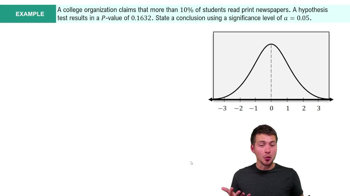Clinical Trial of Echinacea In a clinical trial of the effectiveness of echinacea for preventing colds, the results in the table below were obtained (based on data from “An Evaluation of Echinacea Angustifolia in Experimental Rhinovirus Infections,” by Turner et al., New England Journal of Medicine, Vol. 353, No. 4). Use a 0.05 significance level to test the claim that getting a cold is independent of the treatment group. What do the results suggest about the effectiveness of echinacea as a prevention against colds?
Table of contents
- 1. Intro to Stats and Collecting Data1h 14m
- 2. Describing Data with Tables and Graphs1h 55m
- 3. Describing Data Numerically2h 5m
- 4. Probability2h 16m
- 5. Binomial Distribution & Discrete Random Variables3h 6m
- 6. Normal Distribution and Continuous Random Variables2h 11m
- 7. Sampling Distributions & Confidence Intervals: Mean3h 23m
- Sampling Distribution of the Sample Mean and Central Limit Theorem19m
- Distribution of Sample Mean - Excel23m
- Introduction to Confidence Intervals15m
- Confidence Intervals for Population Mean1h 18m
- Determining the Minimum Sample Size Required12m
- Finding Probabilities and T Critical Values - Excel28m
- Confidence Intervals for Population Means - Excel25m
- 8. Sampling Distributions & Confidence Intervals: Proportion1h 12m
- 9. Hypothesis Testing for One Sample3h 29m
- 10. Hypothesis Testing for Two Samples4h 50m
- Two Proportions1h 13m
- Two Proportions Hypothesis Test - Excel28m
- Two Means - Unknown, Unequal Variance1h 3m
- Two Means - Unknown Variances Hypothesis Test - Excel12m
- Two Means - Unknown, Equal Variance15m
- Two Means - Unknown, Equal Variances Hypothesis Test - Excel9m
- Two Means - Known Variance12m
- Two Means - Sigma Known Hypothesis Test - Excel21m
- Two Means - Matched Pairs (Dependent Samples)42m
- Matched Pairs Hypothesis Test - Excel12m
- 11. Correlation1h 6m
- 12. Regression1h 50m
- 13. Chi-Square Tests & Goodness of Fit1h 57m
- 14. ANOVA1h 57m
9. Hypothesis Testing for One Sample
Steps in Hypothesis Testing
Problem 11.q.3
Textbook Question
Exercises 1–5 refer to the sample data in the following table, which summarizes the frequencies of 500 digits randomly generated by Statdisk. Assume that we want to use a 0.05 significance level to test the claim that Statdisk generates the digits in a way that they are equally likely.

Is the hypothesis test left-tailed, right-tailed, or two-tailed?
 Verified step by step guidance
Verified step by step guidance1
Step 1: Understand the hypothesis test. The null hypothesis (H₀) states that the digits are equally likely to occur, meaning each digit has the same probability of being generated. The alternative hypothesis (H₁) states that the digits are not equally likely to occur.
Step 2: Determine the type of test. Since we are testing whether the digits are equally likely (H₀) versus not equally likely (H₁), we are looking for deviations in either direction. This makes the test a two-tailed test.
Step 3: Review the significance level. The significance level is given as 0.05, which is the threshold for determining whether the observed frequencies differ significantly from the expected frequencies.
Step 4: Calculate the expected frequency for each digit. Since there are 500 total digits and 10 possible digits, the expected frequency for each digit is calculated as: = 50.
Step 5: Use a chi-square goodness-of-fit test to compare the observed frequencies (from the table) to the expected frequencies (calculated in Step 4). The chi-square test statistic is calculated using the formula: , where O represents the observed frequency and E represents the expected frequency for each digit.
 Verified video answer for a similar problem:
Verified video answer for a similar problem:This video solution was recommended by our tutors as helpful for the problem above
Video duration:
2mPlay a video:
Was this helpful?
Key Concepts
Here are the essential concepts you must grasp in order to answer the question correctly.
Hypothesis Testing
Hypothesis testing is a statistical method used to make decisions about a population based on sample data. It involves formulating a null hypothesis (H0) that represents no effect or no difference, and an alternative hypothesis (H1) that indicates the presence of an effect or difference. The goal is to determine whether there is enough evidence in the sample data to reject the null hypothesis at a specified significance level.
Recommended video:
Guided course

Step 1: Write Hypotheses
Significance Level
The significance level, denoted as alpha (α), is the threshold used to determine whether to reject the null hypothesis. In this case, a significance level of 0.05 indicates that there is a 5% risk of concluding that a difference exists when there is none. It helps to control the probability of making a Type I error, which occurs when the null hypothesis is incorrectly rejected.
Recommended video:
Guided course

Step 4: State Conclusion Example 4
Types of Hypothesis Tests
Hypothesis tests can be classified as left-tailed, right-tailed, or two-tailed based on the nature of the alternative hypothesis. A left-tailed test checks for a decrease in the parameter, a right-tailed test checks for an increase, and a two-tailed test checks for any difference in either direction. In this scenario, since we are testing if the digits are equally likely, we would use a two-tailed test to assess deviations in both directions.
Recommended video:
Guided course

Step 1: Write Hypotheses

 6:21m
6:21mWatch next
Master Step 1: Write Hypotheses with a bite sized video explanation from Patrick
Start learningRelated Videos
Related Practice
Textbook Question
